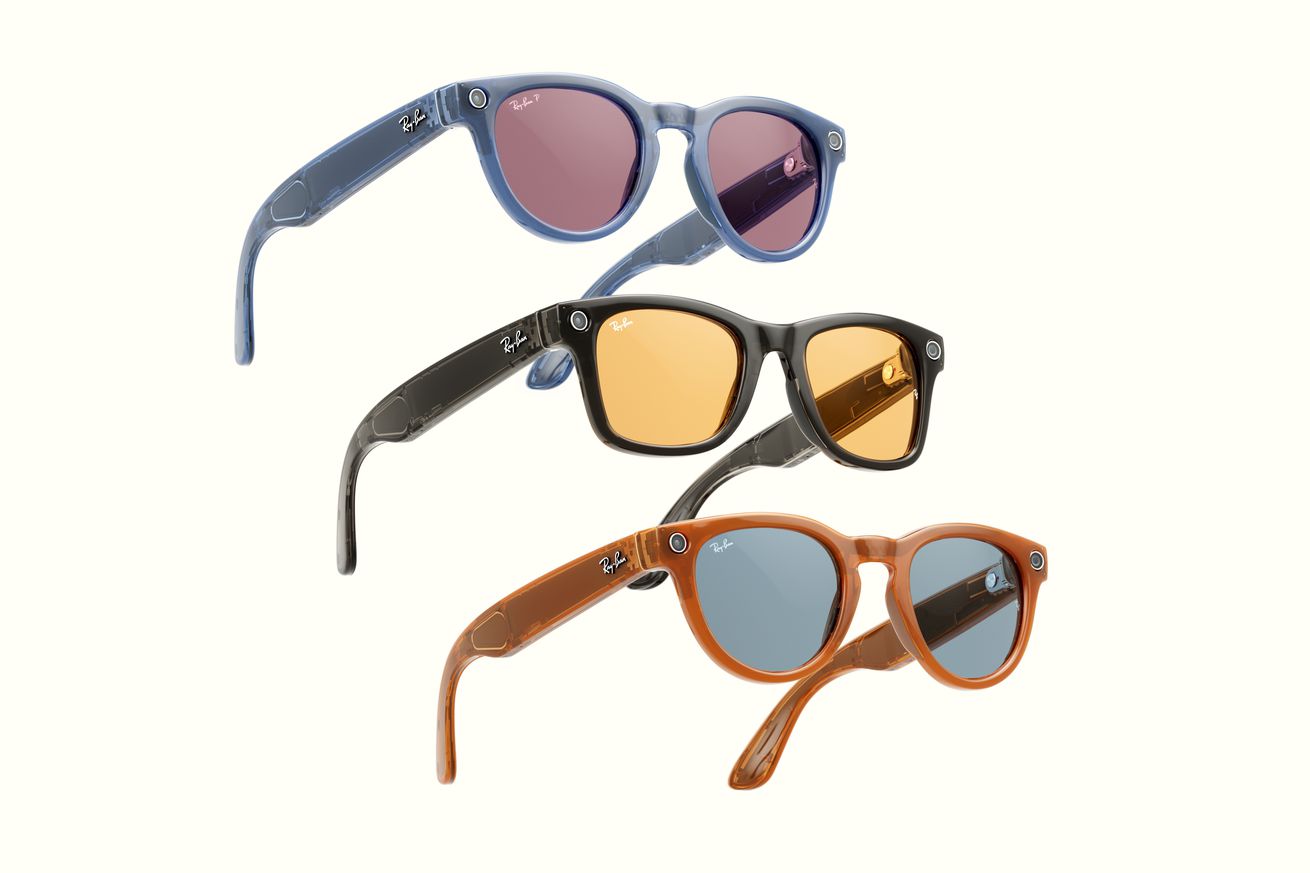They’re still camera glasses, but they’re also decent headphones, and they don’t look half bad. | Image: Meta
Meta’s smart glasses are not called “Stories” anymore. They’re just called smart glasses now. Technically, the new model Meta just announced is called the Ray-Ban Meta Smart Glasses, and the company will happily correct you anytime you call them something else, but these are simply smart glasses. No ifs, ands, or weird names about it.
The new glasses, which Meta just announced at its Connect launch event and which are up for preorder now and will be on sale October 17th starting at $299, have two primary purposes. The first is to replace your headphones: the smart glasses have a similar personal audio system like Amazon’s Echo Frames and the Bose Tempo series, all of which play music but endeavor to make sure only you can hear it. With the new generation of glasses, Meta also upgraded the microphone system in a big way: the specs have five mics, including one in the nose bridge, which should make both your calls and voice commands much clearer. (The Stories only had one mic, and it kind of fell apart in loud or windy conditions.)
The other job of the glasses is as a camera. The smart glasses have small camera lenses on each right temple, just like the Stories — but these cameras take 12-megapixel photos and 1080p videos, both big upgrades from the previous generation. You can store roughly 500 photos and 100 30-second videos (that’s the maximum length the glasses allow) before you fill up the 32GB of internal storage, and everything syncs through the Meta View app. The app also lets you quickly share anything you capture to Meta’s many, many sharing platforms.
In addition to taking photos and videos on the camera, you can also now start a livestream to Facebook or Instagram with just a couple of taps on the stem of the glasses. When you’re recording, a white light around the lens pulses to indicate you’re recording.
Adding livestreaming exacerbates a lot of the product’s already serious privacy questions. It’s also one of Meta’s attempts to answer the big question surrounding all smart glasses: what are you supposed to do with them? Meta reportedly struggled to keep users interested in wearing its Stories, with more than 90 percent of buyers eventually giving up on using their devices.
Last time, Meta’s big pitch was messaging; this time, it’s pitching the smart glasses as more of a creator tool, so you can cook or play drums or do any number of two-handed activities while still recording. One report earlier this year said that the glasses would even let viewers talk back to you, but Meta didn’t mention that capability.
Image: Meta
The new Headliner style is like a more rounded Wayfarer.
Really, any pair of smart glasses has to do one thing first: look nice. To that end, Meta and Ray-Ban built the smart glasses in a bunch of new colors, with names like “matte jeans” and “caramel” and with multiple lens options. The two companies even created a rounder new style called Headliner in addition to the classic Wayfarer.
It all runs on Qualcomm’s Snapdragon AR1 Gen 1 processor, which Qualcomm boasts has “on-glass AI” in a sub-one-watt package, and Meta says the battery inside the smart glasses should last between four and six hours of active use. (And when they’re dead, they’re just, you know, glasses.) The included case can also charge the smart glasses another eight times.
The smart glasses aren’t the screen-having, all-seeing smart glasses Meta has planned for later this decade, but they do seem to have a better shot at actually staying on users’ faces this year, both because of the improved looks and because they just give you more to do with your spectacles. Whether either “audio system in your glasses” or “camera on your face” turn out to be a hit is hard to know, but a surprising number of companies in tech are betting that at least one of them might take off. And if all they turn out to be is a nice-looking pair of shades? That’s a pretty good outcome.



![[CITYPNG.COM]White Google Play PlayStore Logo – 1500×1500](https://startupnews.fyi/wp-content/uploads/2025/08/CITYPNG.COMWhite-Google-Play-PlayStore-Logo-1500x1500-1-630x630.png)